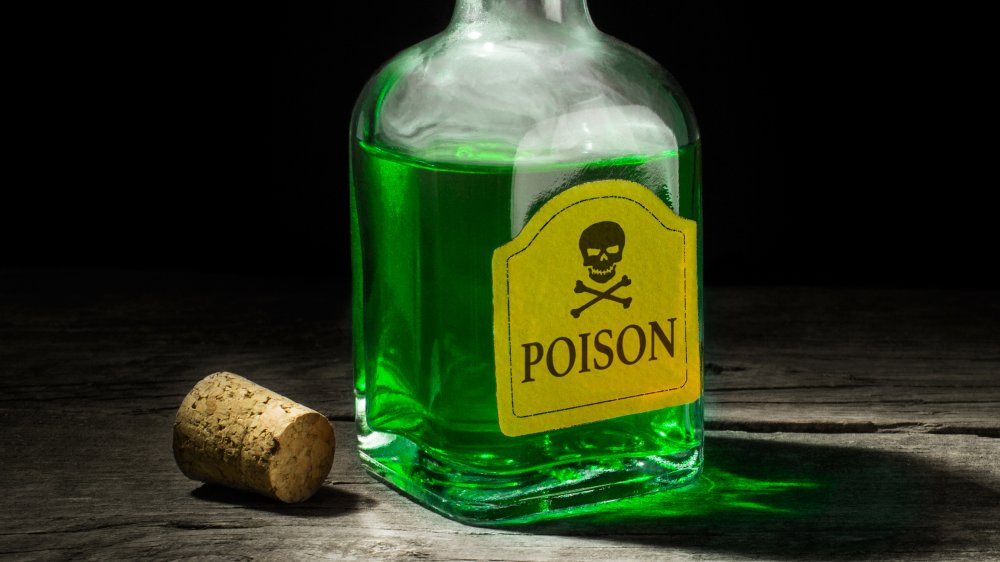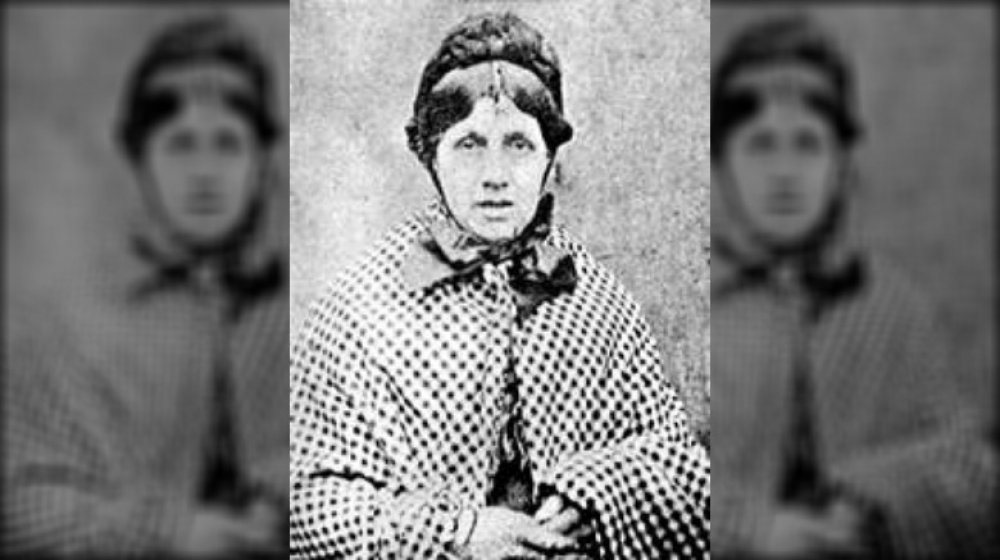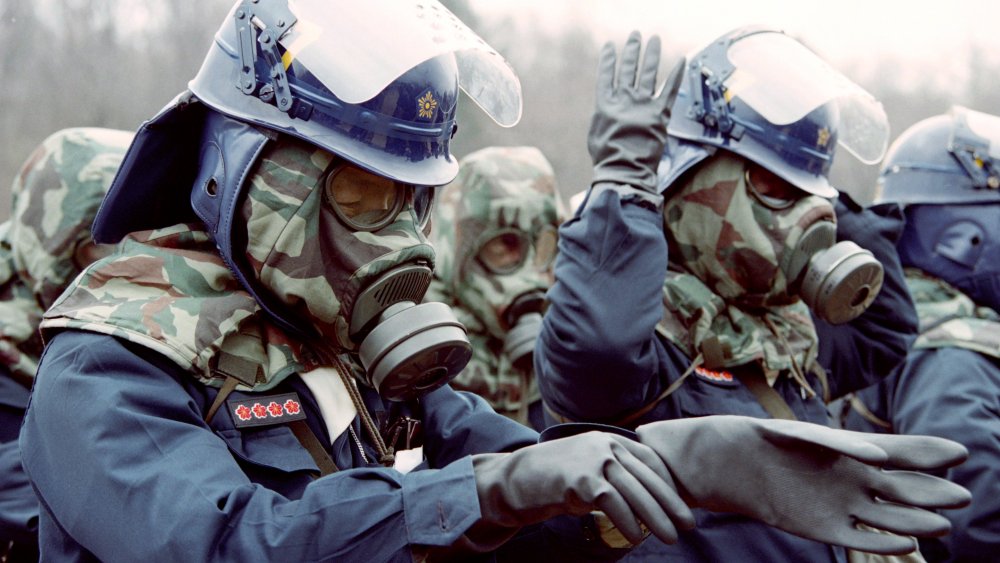The Most Extreme Poisoning Cases In History
It doesn't matter how big you are, how strong you are, or how smart you are, poison will get you. That's why it's one of the oldest methods when it comes to killing. People have been poisoning one another for millennia, and since it was only fairly recently that scientists discovered how to spot the telltale signs of death by poison, it meant this was a great way to get away with murder.
As a result, poison has had a major impact on history. In some cases, it's been used to take out world leaders. In others, it's resulted in massive casualties. And occasionally, it's led to high-profile news stories that have captivated the public and even changed government policies. And today, we're taking a deep dive into the twisted and toxic cases that left a whole lot of bodies in their wake. From ancient Rome to 1980s Chicago, here are the most extreme poisoning cases in history.
The angel makers of Nagyrev
Nagyrev was a small village in rural Hungary, and in 1911, a midwife named Julius Fazekas arrived on the scene (via Medium). No one knew where she came from, only that she was middle-aged and alone. Her husband, rumor had it, had disappeared under suspicious circumstances. She was a welcome sight, as she was the only person with medical knowledge around, and in addition to routine procedures, there were whispers that she was perfectly fine with performing abortions.
Now, the 1910s was a pretty difficult decade. During World War One, the village was turned into a POW camp, and when the war ended, soldiers returned home. Suddenly, the women of Nagyrev found themselves living with traumatized, wounded, and often violent husbands. They told Fazekas about their problems, and she gave them a solution ... literally. She boiled flypaper in a pot on her stove, removing the arsenic and giving village women bottles of the poisonous water.
At least 50 village women bought arsenic from Fazekas, and they dubbed themselves the "angel makers of Nagyrev." They also developed a code — children, women, and male lovers were off-limits, but it wasn't long before the code was broken. Hated relatives, unwanted kids, and parents all began mysteriously dying, but it wasn't until the 1929 census that authorities got suspicious. Ultimately, 12 women were found guilty of murder, with a death toll estimated (via the BBC) to be as high as 300, with 46 confirmed.
The poisoning case that changed Roman history
Finding out the truth about some of the most notorious figures of the ancient world is something of a problem. After all, many exist somewhere between history and legend, and that's certainly the case with Locusta, a woman famous for her ability to brew up some really deadly potions.
According to Toxicology in Antiquity (via Science Direct), Locusta's skill with poison was well-known across the very messed up Roman Empire, as she was convicted of numerous crimes during the reign of Claudius. But ancient Roman rulers were nothing if not resourceful, and they knew a valuable asset when they saw one. It's believed that Agrippina — Claudius's second wife — was the one who had her prepare a poison to dispatch Claudius in order to clear the way for Nero. Agrippina requested something that would delay death until after the banquet where he was served the poison in his favorite dish — mushrooms — and he died well after being carried from the banquet in a state that looked like drunkenness.
That's the oft-told story, at least, and there are a few others guesses as to exactly what happened. Locusta is always at the center, though. She also prepared a poison to take out Nero's rival to the throne, Britannicus. Nero was so happy with her performance that he pardoned her, gave her a massive estate, and sent her students to teach. According to Executed Today, Locusta remained a devoted henchman of Nero for 14 years, so when his successor, Galba, came to power, one of the first things he did was execute her.
The Bradford Sweets Poisoning
Not all poisonings are done on purpose. Sometimes, they're a terrible, tragic mistake, and one such a mistake happened in Yorkshire in 1858. That's when more than 200 people around Bradford got sick and at least 20 died. The culprit? A particular kind of candy called a humbug, sold from a single market stall. And what happened, says Historic UK, was completely avoidable.
At the time, the price of sugar was ridiculously high. It was so high, in fact, that many confectioners — especially those who catered to the working class — substituted a perfectly safe mix of plaster of Paris and limestone for the sugar in their recipes. It was called "daft," and it was gross but definitely not poisonous. It also looked exactly like arsenic.
But when one local candymaker named William Hardaker — or, more popularly, Humbug Billy — stopped at his usual pharmacy in Shipley to pick up a batch of daft for his candies, he didn't get daft. The pharmacy had mixed up the labels on daft and arsenic, so when the 40-pound batch of humbugs was made, each sweet had enough arsenic that it could theoretically kill two people. It's a miracle more people didn't die, and while those involved were charged with manslaughter, no one was convicted. It did lead to stricter legislation governing the handling and labeling of both poisons and medicines, though.
The Esing Bakery Incident
Arsenic was at the center of the event described by the South China Morning Post as both the "Esing Bakery incident" and the "great bread poisoning incident." It happened on January 15, 1857, and no one has ever been entirely sure just what happened ... but there's been plenty of speculation.
A British colony at the time, Hong Kong was around ten years old when the incident went down, and a single baker named Cheong Ah-lum baked almost all of the city's bread. According to the official version of events, "one day, through carelessness, [Cheong] dropped some odd things into the flour. When the Westerners bought and ate the bread, they all felt sick and fainted." In other words, it was an unfortunate accident.
However, the "odd things" dropped into the bread was arsenic. Fortunately, everyone who ate the bread threw up the poison before it could kill anybody, although some were said to have suffered lasting effects. Hundreds of people were sickened, including Cheong's own children. He was ultimately acquitted of any wrongdoing, but he was later arrested again and banished from the city. Don't feel too bad for him, though. He became a consul for the Qing imperial court and lived a pretty decent life.
Mary Ann Cotton was one of history's most notorious poisoners
Back in the day, Mary Ann Cotton was the subject of a nursery rhyme, because the Victorian Era was very messed up. This lovely little poem went, "Mary Ann Cotton, she's dead and she's rotten, she lies in her bed with her eyes wide open." Yeah, it was a different time.
So, who was she? Well, she was a murderer, but according to Executed Today, it's impossible to tell just how many people she killed because her favorite method of poisoning — with arsenic — simply showed up on death certificates as gastroenteritis or a similar ailment of the digestive tract. But given that her first three children and perhaps another four died of mysterious gastric conditions, along with her first husband, well, it's hard not to see a pattern developing. And those were just the first who mysteriously passed away.
Her second husband, George Ward, lasted a year before he died, leaving Mary with an insurance policy as consolation. James Robinson was almost next, but he kicked her out when he caught her stealing, but it wasn't in time to save his three children and two more of hers, who died mysteriously. Next, she was on to Frederick Cotton, and yeah, he also died, alongside one of her lovers and a few more children.
There's only so long people can look the other way and not get suspicious, and these last deaths coincided with the discovery of a test that would detect the presence of arsenic. As a result, she was hanged in a botched execution, says The Telegraph, but there was little sympathy for her.
The Affair of the Poisons
The Affair of the Poisons was a massive scandal that kicked off in the French court in April 1679, and Britannica says that by the end, 36 people were handed a death sentence and 319 were arrested. And it all revolved around Madame de Montespan, mistress to Louis XIV, who was accused of visiting one of a number of female fortune tellers for a little guidance on how to keep the king's interest. After all, he was starting to show a little more favor to the younger Mlle de Fontanges. Faced with the possibility of being usurped by a younger woman, de Montespan was desperate. And as it turns out, the women she was consulting with weren't just fortune tellers. They were also said to conduct black masses and mix all kinds of potions, philtres, and — if those didn't work — poisons.
The most famous of these women was Catherine Monvoisin, who turned to fortune telling after her husband's jewelry business failed. According to Headstuff, many of her clients were dealing with the matter of carrying an unwanted child, so she helped them solve their problems. It wasn't long before nobility in the French court sought her out, and soon, she was also selling poisons to women who wanted out of their marriages. She was arrested in 1679, and her case involved a lot of wild accusations, and there's no way of telling what's actually true. We do know that she was found guilty and burned at the stake. Most of the members of the court who were implicated in the poisonings simply and conveniently disappeared. As for de Montespan, who allegedly tried to kill the king and his mistress, well, nothing was ever proven.
The true story behind Japan's doomsday cult
On March 20, 1995, Japan suffered a deadly, coordinated attack on three separate train lines in five separate incidents. Around 5,800 people were injured and 13 died when packages filled with sarin — a toxic nerve agent developed in Nazi Germany — started leaking poison into train cars. Behind the attacks was Aum Shinrikyo, a doomsday cult formed in the 1980s. According to the BBC, their mix of Buddhist and Hindu beliefs elevated their founder, Shoko Asahara, to both the reborn Christ and the modern world's Buddha. The group was recognized as a formal religion in 1989, boasting tens of thousands of members, and gradually, they began to preach that only their followers would survive World War III.
The 1995 attack wasn't the only one, either. They'd previously been behind another sarin incident in 1994 that poisoned around 600 people and killed eight. The BBC says that the attacks were carried out by cult members who thought they were doing something good. Asahara preached that anyone killed by a member of the cult would have their soul saved from a lifetime of damnation. And evidently, Asahara's followers fell for this line of thinking, and they also staged attacks with hydrogen cyanide that ultimately failed. Seven of the cult's leaders — including Asahara — were executed in 2018, but believe it or not, the cult is still active today.
Michael Swango was pure evil
When The Washington Post looked back over Dr. Michael Swango's career as a serial poisoner, they were shocked by how many times he should've been caught. That started early in his career, when he was doing a residency at Ohio State University, and patients had a tendency to die after he was seen in their rooms, adjusting their IVs. Nurses raised the alarm, but one half-hearted investigation and a few letters of recommendation later, and he was on his way to the next set of victims.
That next group was comprised of his coworkers. Back in his hometown of Quincy, Illinois, he was caught poisoning the others who worked on the ambulance crew with him, as he'd brewed tea with a slew of heavy metals. After law enforcement found a treasure trove of poisons in his apartment, he was given five years in jail, but shockingly, he was out and back into a residency at the University of South Dakota by 1992 ... and more people began to die.
His history is a long series of jumping ship just in time, lying his way into another job, and killing more. This dude wound up at the State University of New York at Stony Brook, the Northport VA Hospital, even in Zimbabwe and Saudi Arabia. By 1997, he was arrested on suspicion of his involvement in at least 60 murders, and in 2000, he was sentenced to life in prison without the possibility of parole (via BMJ).
The tale of Dr. Hawley Crippen
Hawley Harvey Crippen and Cora Turner were married in 1893 and moved from the U.S. to London a few years later. However, Turner was a powerful personality who knew what she wanted, and her husband wasn't it. While she chased her dream of being in show business, her husband chased someone else, a typist named Ethel Le Neve. Then on January 31, 1910, the Crippens threw a dinner party, and afterward, no one ever saw Cora Turner alive again.
According to The History Press, that's when Crippen started claiming she'd returned to America. The story changed a few more times before Crippen and his lover fled the country, and a body — missing a head, limbs, and bones — was discovered under the floorboards of the Crippen home. When tests seemed to confirm that the body was Turner and that her remains contained a poison called hyoscine, it took just half an hour for a guilty verdict to come back, and Crippen was hanging in 1910.
It seems pretty straightforward, but a century later, some experts aren't so sure for one very important reason. Testing the mitochondrial DNA revealed the fact that the body wasn't Turner's at all. Heck, it wasn't even a woman. But not everyone was swayed, and as the BBC says, even though the case was appealed, it wasn't reopened, as Crippen's champion — a second cousin, three times removed, named JP Crippen — was ruled to be not closely related enough to have an interest in the case.
The bizarre story of the Philadelphia poison ring
The Great Depression was a weird time to be alive, but despite the economic hardships, people still had to make a living. As a result, some turned to crime, and a few of those people got really creative with it.
Paul and Herman Petrillo were cousins who immigrated to Philadelphia during World War I, and their skill set didn't exactly scream "poisoners." Paul was a tailor, and Herman sold spaghetti, but starting in 1932, they remade themselves as "spiritual counselors" and gave unhappy women "love potions." If their man was good at heart, they said, it would "cure" whatever the complaint was, whether it was a tendency toward violence, alcoholism, etc. If he was evil, though, it would kill him. It usually killed him.
They didn't stop there, either. According to Thought Catalog, the Petrillos branched out in two different ways. They hired women to sell unhappy husbands the same spiel, and they also set up their own matchmaking agency. The Philadelphia Inquirer says it went like this. They approached some widows and hooked them up with husbands. They also made sure those new husbands had hefty insurance policies — which always paid more in case of accidental death — and then they made sure those husbands had accidents. The local press eventually dubbed the Petrillos and their ever-growing gang as "Arsenic Incorporated," since that was a favorite poison of theirs, and it wasn't until an inside man came forward that the cousins were sent to the electric chair.
The infamous Chicago Tylenol murders
The series of tragic deaths known as the Chicago Tylenol murders started on September 29, 1982, when a 12-year-old girl complained of cold symptoms, was given a single Tylenol capsule, and died soon after. The next victim was a 27-year-old postal worker, who died from what was originally called a heart attack. In the wake of his death, both his brother and sister-in-law took Tylenol from a bottle in his home to calm their headaches — and yeah, they also died. In total, seven people passed away from taking Tylenol that had been laced with cyanide. Around 31 million bottles of Tylenol were recalled, more poisoned bottles were found, and several more copycat incidents popped up over the next decade.
According to PBS, the poisoner or poisoners were never found. But the incident did have a long-lasting impact on the pharmaceutical world. Tylenol manufacturers Johnson & Johnson worked with the FDA to create new packaging that made it very, very obvious if anyone opened or punctured seals on bottles. They also redesigned the pills themselves, into a form that couldn't be opened, tampered with, and reassembled. After investing more than $100 million into the redesign, medicine was made much safer — and much more annoying to open for even the most legitimate reasons.











